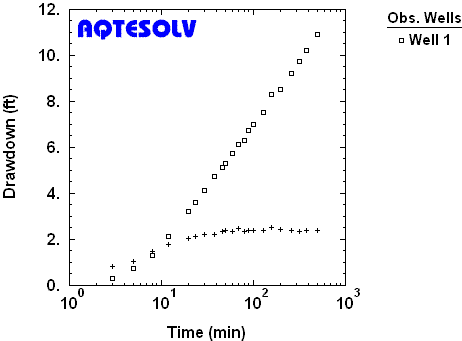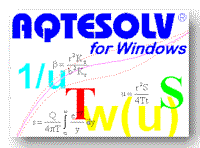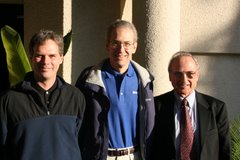At the outset of interpreting a pumping test, an important feature to
detect in the response data is
infinite-acting radial flow. During infinite-acting radial flow, steady pumping in a nonleaky
confined aquifer of infinite extent produces late-time drawdown that changes with the logarithm of
time since pumping began. Infinite-acting behavior occurs after wellbore storage effects have dissipated and before the influence of aquifer boundaries. One may observe this flow regime by plotting the familiar
Theis (1935) solution on semilog axes (Figure 1); at late time, a graph of dimensionless drawdown, w(u), versus dimensionless time, 1/u, plots as a straight
line and the
logarithmic derivative is constant.
 |
| Figure 1. Infinite-acting radial flow in a nonleaky confined aquifer illustrated with Theis (1935) solution (dimensionless drawdown and dimensionless derivative shown by blue and red curves, respectively). |
This late-time behavior of the Theis model is well known to groundwater hydrologists. The period of infinite-acting radial flow is the basis for the tried-and-true
Cooper and Jacob (1946) method which
one may use to find the transmissivity and storage coefficient of a nonleaky confined aquifer by matching a straight line to late-time drawdown data from a constant-rate pumping test plotted on semilog axes.
A
derivative plot is very useful for detecting the infinite-acting radial flow regime under steady pumping conditions. One starts by looking for a
derivative plateau (constant derivative) to tentatively identify infinite-acting radial flow. For example, the response data from a constant-rate pumping test shown in Figure 2 suggest that infinite-acting radial flow conditions are present after approximately 30 minutes of pumping once the derivative stabilizes.
 |
| Figure 2. Derivative plot of drawdown (squares) and derivative (crosses) measured in an observation well during constant-rate pumping test in a nonleaky confined aquifer (Walton 1962). |
Note that the derivative plateau in Figure 2 exhibits some noise; derivative fluctuation at the plateau is common in the
application of derivative analysis, but the presence of a near-constant derivative in this example is clear and corresponds to the emergence of a well-defined straight line in the drawdown data.
The foregoing results suggest that the derivative plot is an indispensable tool for aquifer test interpretation; however, the mere existence of a derivative plateau does not immediately confirm infinite-acting radial flow conditions. For example, an
aquifer limited by a no-flow boundary can produce a constant derivative that is not diagnostic of the infinite-acting radial flow regime. In such a situation, geologic mapping of lithologic contacts, faults and other low-permeability features would be invaluable in making a correct interpretation.
Visit
Aquifer Testing 101 for a
catalog of derivative plot signatures with more examples of
infinite-acting radial flow in pumping tests.
Follow
HydroSOLVE on
LinkedIn!


